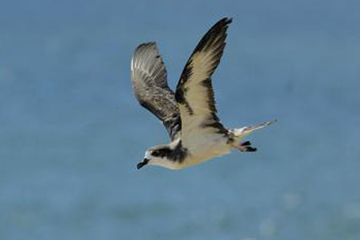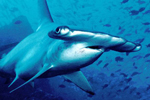The bleached bones of seabirds are telling us a new story about the far-reaching impacts of industrial fisheries on today’s oceans. Looking at the isotopes of 250 bones from Hawaiian petrels (Pterodroma sandwichensis), scientists have been able to reconstruct the birds’ diets over the last 3,000 years. They found an unmistakable shift from big prey to small prey around 100 years ago, just when large, modern fisheries started scooping up fish at never before seen rates. The dietary shift shows that modern fisheries upended predator and prey relationships even in the ocean ocean and have possibly played a role in the decline of some seabirds.
“Hawaiian petrels spend the majority of their lives foraging over vast expanses of open ocean. In their search for food, they’ve done what scientists can only dream of. For thousands of years, they’ve captured a variety of fish, squid and crustaceans from a large portion of the North Pacific Ocean, and a record of their diet is preserved in their bones,” Anne Wiley, lead author of the new paper in the Proceedings of the National Academy of Sciences (PNAS), explains.
 A Hawaiian petrel flies over part of its Pacific Ocean foraging grounds. Photo by: Jim Denny. |
To conduct their study the researchers turned to a vast collection of Hawaiian petrel bones found in cave colonies, some of them preserved from long before the first humans arrived on the Hawaiian Islands. By comparing the ratio of nitrogen-15 and nitrogen-14 in the bones’ isotopes, Wiley and colleagues were able to tell what the generalist predators were eating. The larger the ratio, the bigger the prey. For thousands of years the birds’ diet was heavily composed of bigger prey, until nitrogen ratios shrunk around a century ago denoting a suffen shift of small prey species. According to the paper, this “[suggested] a relatively rapid change in the composition of oceanic food webs in the Northeast Pacific.”
Co-author Peggy Ostrom with Michigan State University calls the findings “alarming,” noting that the study is one of the first to discover that industrial fishing has impacted non-target species and food webs even as far as the open ocean.
“Because Hawaiian petrels eat such a wide variety of prey over a large area, our results suggest that fishery influence may be widespread and profound in the Pacific,” explains Wiley. “Understanding the influence of fisheries on open-ocean food webs has been one of the great mysteries of biological oceanography.”
 400- to 1,000-year-old bones from an endangered seabird, the Hawaiian petrel. These bones represent a small fraction of those collected from the species. They offer a window into the lives of seabirds before and after the arrival of humans in the open ocean environments of the Pacific. Photo by: Brittany Hance, Smithsonian Institution. |
The scientists believe this forced dietary change may have conservation impacts as well. They theorize that the shift may have limited total population number in addition to possibly shrinking the size of the seabirds. Hawaiian petrels are currently listed as Vulnerable by the IUCN Red List and is protected under the U.S. Endangered Species Act (ESA).
“Conservation efforts for most seabirds focus on breeding grounds where habitat loss and predation from introduced species are obvious hazards. However, rapidly shifting or disappearing prey bases may be a hidden threat to Hawaiian petrels and other marine species,” the authors write.
Seabirds are among the world’s most endangered birds: 28 percent of the world’s sea birds are threatened with extinction, while 48 percent are seeing population declines. In addition to prey decline, seabirds have also suffered heavily from industrial fisheries as bycatch. Longline fisheries alone are estimated to kill 160,000-320,000 seabirds every year.
CITATION: Anne E. Wiley, Peggy H. Ostrom, Andreanna J. Welch, Robert C. Fleischer, Hasand Gandhi, John R. Southon, Thomas W. Stafford, Jr., Jay F. Penniman, Darcy Hu, Fern P. Duvall, and Helen F. James. Millennial-scale isotope records from a wide-ranging predator show evidence of recent human impact to oceanic food webs PNAS 2013 ; published ahead of print May 13, 2013, doi:10.1073/pnas.1300213110
Related articles
What if companies actually had to compensate society for environmental destruction?

(04/29/2013) The environment is a public good. We all share and depend on clean water, a stable atmosphere, and abundant biodiversity for survival, not to mention health and societal well-being. But under our current global economy, industries can often destroy and pollute the environment—degrading public health and communities—without paying adequate compensation to the public good. Economists call this process “externalizing costs,” i.e. the cost of environmental degradation in many cases is borne by society, instead of the companies that cause it. A new report from TEEB (The Economics of Ecosystems and Biodiversity), conducted by Trucost, highlights the scale of the problem: unpriced natural capital (i.e. that which is not taken into account by the global market) was worth $7.3 trillion in 2009, equal to 13 percent of that year’s global economic output.
China ‘looting’ Africa of its fish
(04/24/2013) Just 9% of the millions of tonnes of fish caught by China’s giant fishing fleet in African and other international waters is officially reported to the UN, say researchers using a new way to estimate the size and value of catches. Fisheries experts have long considered that the catches reported by China to the UN’s Food and Agriculture Organization (UNFAO) are low but the scale of the possible deception shocked the authors.
Breaking the mold: Divya Karnad takes on fisheries and science journalism in India

(04/15/2013) Fishing is not a woman’s domain in most countries across the globe. In parts of India there are fishing communities who believe that having a woman onboard a fishing boat brings bad luck. Despite this, Divya Karnad, a scientist who studies marine life in India, has spent several years studying fisheries and their impact on species like sharks and sea turtles. Her work forms a part of global efforts to track declining marine species and encourage more sustainable fishing.
Heavy metal shark meat: dangerous lead levels found in sharks used as fish food

(03/18/2013) A recent study published in mongabay.com’s open access journal Tropical Conservation Science raises concerns about levels of heavy metals, particularly lead (Pb), present in shark meat, as well as the decline of shark abundance due to global fishing pressures. Sharks are primarily caught as by-catch for other fishing industries. By one account, 70% of the total catch in swordfish long-line fisheries was sharks. Due to consumer demand, this by-catch is sold to Asian fish markets as fin and trunk meat. Much of the trunk and organ meat is used to make fish-meal, which is then fed to farmed fish.
Sharks and rays win protections at CITES

(03/11/2013) Today, for the first time, sharks and rays have won the vote for better protection under CITES (the Convention on International Trade in Endangered Species), the world’s regulating body on trade in threatened species. Five shark species and manta rays, which includes two species, have received enough votes to be listed under Appendix II of CITES, which means tougher regulations, but not an outright ban. However, the votes could still be overturned before the end of the meeting.
Has shark fin consumption peaked at 100M dead sharks per year?

(03/05/2013) While a new study warns that up to 100M sharks are killed annually, there are signs out of China that demand for shark fin may be on the decline. A study published last week in the journal Marine Policy estimated shark deaths at 100 million in 2000 and 97 million in 2010, suggesting a slight drop in shark killing. Meanwhile reports out of China in recent months suggest an accelerating decline in shark fin consumption. China is the top market for shark fin, which is consumed as a status symbol, typically at wedding ceremonies and business dinners.
Saving manta rays from the fin trade

(01/15/2013) Tens of millions of sharks and rays are killed each year to meet demand for shark fin, a delicacy across East Asia. But while the plight of sharks has gained prominence in international environmental circles in recent years, the decline in rays has received considerably less attention. A new film, Manta Ray of Hope, aims to change that. Produced by cinematographer, scuba diver, and marine conservationist Shawn Heinrichs, Manta Ray of Hope offers a look at the mysterious and magnificent world of the world’s largest ray, the manta ray. The film highlights both the threats mantas face as well as some of the people who are working to save them.

(01/10/2013) Global strategist, trained educator, and international lecturer Daniel Rirdan set out to create a plan addressing the future of our planet. His book The Blueprint: Averting Global Collapse, published this year, does just that. “It has been a sixty hour a week routine,” Rirdan told mongabay.com in a recent interview. “Basically, I would wake up with the burden of the world on my shoulders and go to sleep with it. It went on like this for eighteen months.” It becomes apparent when reading The Blueprint that it was indeed a monumental undertaking.
The genetically modified ‘Frankenfish’ salmon soon in a plate near you
(01/10/2013) The U.S. Food and Drug Administration (FDA) has partially approved the AquAdvantage Salmon, a genetically engineered salmon that grows twice as fast as normal. The FDA states that the GM salmon is “safe and unlikely to harm the health of the consumers or the environment”.
Photo: Bluefin tuna sells for record $1.76 million in Japan
(01/05/2013) A bluefin tuna sold for a record $1.76 million at an auction in Tokyo, Japan Saturday, reports the Associated Press.
Obama triples area of protected California coastline
(12/20/2012) Today President Obama announced the government would add almost 3,000 square miles of California coastline to the National Marine Sanctuary system, roughly tripling its size, reports the Sierra Club.